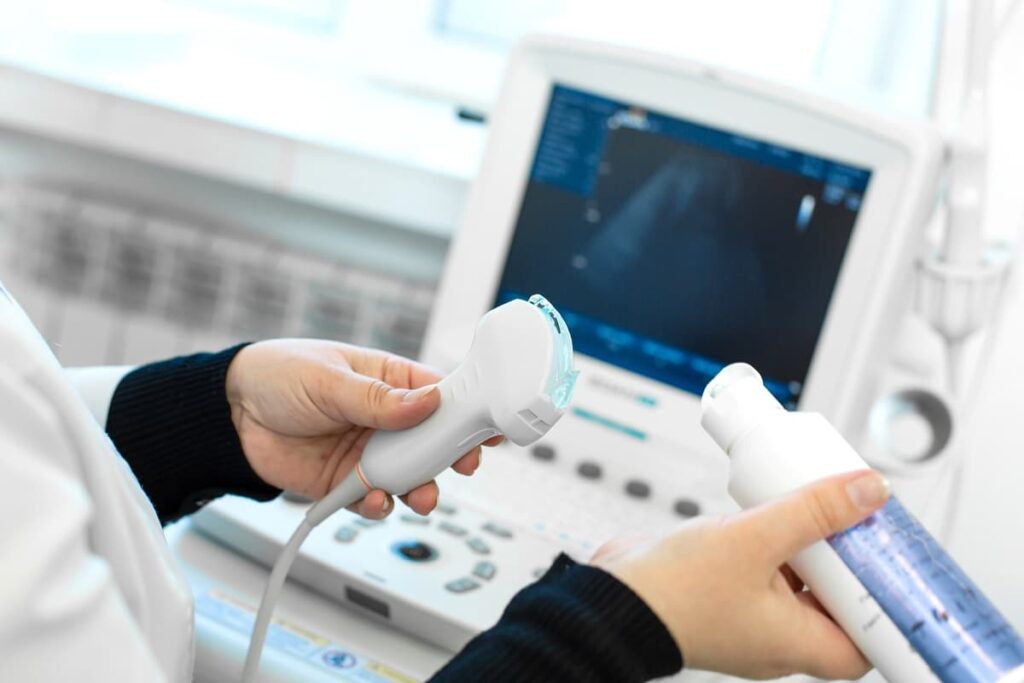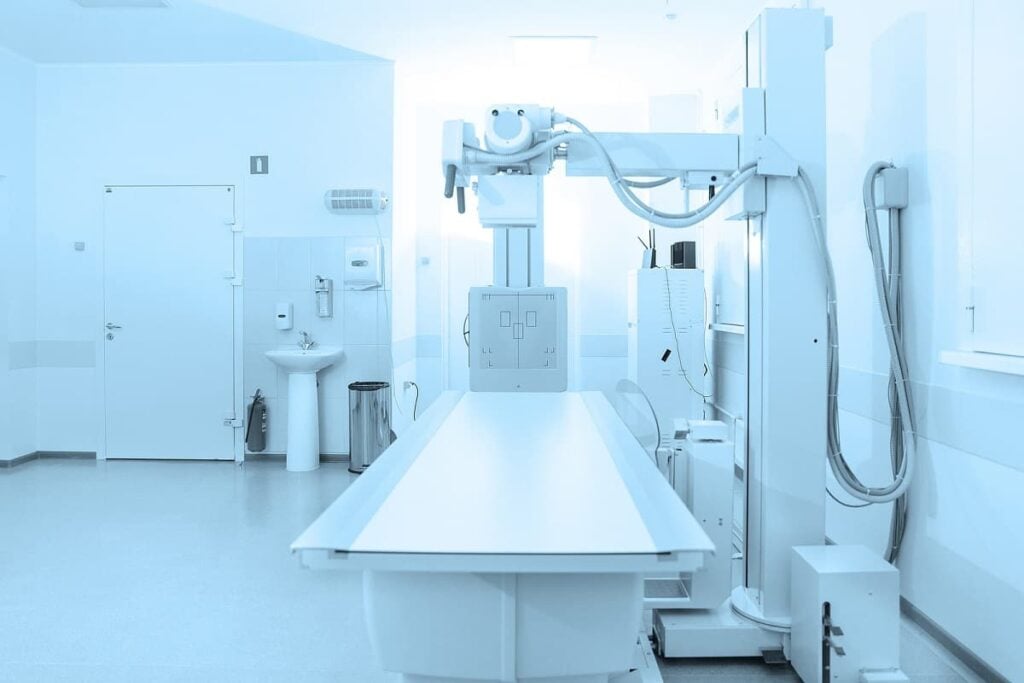Ultrasound Technology for 5 Types of Medical Conditions
Table of contents

Aside from destroying the social fabric of our society, Facebook has enabled a whole generation of parents to post endless photos of their little rug rats doing all sorts of nauseatingly cute things. New parents are probably the worst, celebrating the life of their child every few weeks, as if we still lived in the Dark Ages when most kids succumbed to the plague before age 3. They even upload ultrasound images that look like a cross between a Roswell, New Mexico alien baby, and a reptile. Or a hairless, mini Willem Dafoe. And like Dafoe, ultrasound technology has been with us since the mid-1950s as an imaging and diagnostic tool. What you may not know is that ultrasound technology is also widely used in a variety of life sciences use cases, from destroying kidney stones and cancer tumors to promoting healing of muscles and bones.
How Does Ultrasound Technology Work?
First, the terminology. From Healthline.com:
An ultrasound is a tool used to take a picture. A sonogram is the picture that the ultrasound generates. Sonography is the use of an ultrasound tool for diagnostic purposes.
Next, a super-quick refresher on how ultrasound technology works in general, courtesy of the National Institutes of Health (NIH).
Ultrasound is a form of acoustic energy with frequencies higher than the human ear can detect. A key component of an ultrasound machine is the transducer, which can both emit ultrasound waves and detect echoes reflected back. The active elements in ultrasound transducers, which look like the handheld scanners used in the checkout line at Home Depot, are usually made of special ceramic crystal materials called piezoelectrics that produce sound waves when an electric field is applied to them.

As an imaging device, the transducer emits high-frequency sound waves that hit a target – like an alien Willem Dafoe fetus in the womb – that are then reflected back to the instrument. The reflected sound waves generate electrical signals that the ultrasound scanner uses to create two-dimensional images based on the speed of sound and the time of each echo’s return. There’s no dangerous radiation like you get with an X-ray machine. Ultrasound technology has matured to the point where startups like Butterfly Network have developed handheld devices that use a smartphone to operate.
Types of Ultrasound Therapy
Ultrasound therapy also uses high-frequency sound waves but does not produce images. Instead, the acoustic energy can interact with soft body tissue in various ways. There are two main types of ultrasound therapy: thermal and mechanical.
Thermal ultrasound therapy, as the name implies, brings the heat by continuously emitting sound waves that cause microscopic vibrations in the deep-tissue molecules. The excited molecules increase heat and friction, creating a warming effect that can help tissues heal at the cellular level. A technique called high-intensity focused ultrasound (HIFU) can be used to ablate, or destroy, tumors and benign growths. Mechanical ultrasound technology, on the other hand, uses pulses of sound waves that cause the expansion and contraction in the tiny gas bubbles of the soft tissues, which can reduce inflammation and pain. There is also a mechanistic version of HIFU called histotripsy, which causes tumors to liquefy, a bit like the liquefaction that occurs during an earthquake.

Some of these ultrasound therapies are more advanced than others. Let’s take a closer look at the ultrasound technology that a few companies have developed for five types of medical conditions
Incisionless Brain Surgery
The first company on our list is also a unicorn, a startup valued at more than $1 billion, as of this year. Founded way back in 1999, InSightec out of Israel has raised nearly $500 million at a valuation of $1.3 billion. It raised a $150 million Series F in March, which included $100 million from a subsidiary of Koch Industries. Koch Industries also took the lead on a $150 million Series E in December 2017 that included GE Healthcare, among others. The company’s platform is based on HIFU technology to treat what are called essential tumors that cause uncontrollable shaking, such as that experienced by those stricken with Parkinson’s disease. The results are pretty impressive:

InSightec’s neurosurgery platform, Exablate Neuro, delivers ultrasound energy deep in the brain to create a lesion with no incisions. A neurosurgeon sits at a computer console where an MRI provides the real-time imagery to guide the ultrasound treatment, which begins with low energy until the target has been verified by the patient’s physical responses. Once confirmed, the energy is gradually increased to create a highly accurate and controllable lesion. A clinical study of the ultrasound technology found tremors had improved by more than 75% over baseline after three years. Exablate Neuro is FDA-approved and found in more than 65 medical centers globally.
Killing Liver Cancer Cells
While based in Minnesota, the ultrasound technology being commercialized by HistoSonics, histotripsy, was originally pioneered at the University of Michigan, so at least they’re keeping it all in the Midwest. Founded in 2009, HistoSonics has raised a total of about $127 million, including a $40 million Series C just a couple of days ago. Again, think of histotripsy as almost like sending a series of shock waves into the body, in this case precisely targeting cancer cells, which liquify under the acoustic assault. The device, dubbed Edison, looks like any other robotic surgery arm:

A liver cancer study published earlier this year that used the HistoSonics robotically positioned histotripsy system showed that the medical device not only disintegrated targeted tumors but had a desirable side effect for a couple of patients. Specifically, the treatment caused an immune response that helped stabilize or even decrease other cancer tumors in the body at eight weeks.
Treating Disease Below the Waist
Back on the hot side, Profound Medical (PRN) is a publicly traded Canadian company that has developed a couple of HIFU-powered medical platforms. Founded in 2008, Profound Medical had raised about $73 million before a reverse merger in 2015 that landed the company on the Toronto Stock Exchange. Sporting a market cap just north of $270 million, Profound Medical closed its most recent quarter at a loss of about $2.7 million. Last year, Profound Medical reported $4.4 million in revenue, mostly on the sale of its two products, while tallying $15 million in losses.

Profound Medical has two medical devices in its portfolio. The Tulsa-Pro uses ultrasound to burn out cancer cells around the prostate while protecting sensitive bits like the urethra and rectum. The Sonalleve offers an incision-free alternative to traditional surgical treatments of uterine fibroids, noncancerous growths of the uterus. It can also help pain associated with bone metastases from cancer.
Breaking Up Kidney Stones
San Francisco Bay Area startup SonoMotion is developing a new type of ultrasound technology to address one of the earliest use cases for ultrasound therapy: kidney stones. Founded in 2014, the company has raised about $22.5 million in venture funding and grants, including from NASA and NIH. Based on research at the University of Washington, SonoMotion is developing two devices for breaking up kidney stones using a technique first introduced in the 1980s called lithotripsy. Its first device, Break Wave, is a mechanistic ultrasound therapy, delivering cycles of acoustic pulses that facture the kidney stones at lower pressures compared to traditional methods of lithotripsy. The handheld instrument also uses real-time ultrasound image guidance to locate the stone. The company sponsored a clinical trial that started late last year to test the safety and efficacy of the treatment on 30 patients, but no word on the results yet.
The second instrument, Stone Clear, removes the leftover fragments within 15 minutes as an out-patient service. A clinical trial on the device is pending.
Wearable Ultrasound for Pain Relief
Another company with government backing from NASA and NIH, along with the National Science Foundation and Department of Defense is ZetrOz out of Connecticut. Founded in 2009, the company has wrangled about $13 million in funding over the last decade to develop wearable ultrasound technology for tissue healing and pain management. Dubbed sam, for sustained acoustic medicine, the device delivers a continuous low-intensity acoustic wave to provide relief of things like osteoarthritis and back pain related to herniated disks. There is a sam 2.0 and sam Sport, but we’re not entirely clear on the differences, except the latter is marketed to athletes for pain associated with tendon, ligament, or muscle injuries by penetrating a couple of inches into the tissue.

ZetrOz says its wearable ultrasound devices are FDA-cleared and are even covered by some insurance plans. The whole concept sounds a bit like some electroceutical devices that use electricity for pain relief rather than acoustic energy.
Conclusion
Ultrasound technology could potentially change how we treat diseases like cancer, attacking the tumor cells without the need for radiation and other therapies that are often as bad as the illness itself. The fact that these techniques don’t require invasive surgery is another huge plus, as superbugs and hospital-acquired infections are a huge risk to the health of patients. While the studies are mixed about the overall effectiveness of ultrasound therapy for certain treatments, the latest wave of innovation seems to have some sound science behind it – not to mention, some serious dollars as well.
Sign up to our newsletter to get more of our great research delivered straight to your inbox!
Nanalyze Weekly includes useful insights written by our team of underpaid MBAs, research on new disruptive technology stocks flying under the radar, and summaries of our recent research. Always 100% free.



















